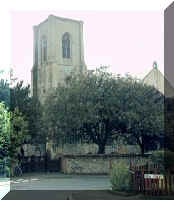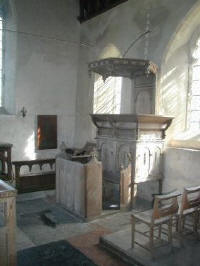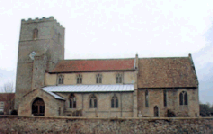
|
|
|
You will then need to navigate back to this page using the County Index |
|
Churches which still retain west gallery features or connections |
|||||||||||||||||||||||||||||
| Aylsham, St Michael | A 15th C. church, with a 17th C. west gallery "supported on arched braces with tracery in the spandrels." (Pevsner) | ||||||||||||||||||||||||||||
|
Barnham Broom, St Peter and St Paul
|
|
||||||||||||||||||||||||||||
| Berg Apton, St Peter & St Paul | |||||||||||||||||||||||||||||
| Brisley, St Bartholomew | The church has a notable 15th C. west tower, and stands in the centre of the village. ". . . though the church is in a deplorable condition the medley of 15th C. woodwork worked up into box-pews and a three-decker, and the uneven flooring . . . give the feeling of a Rowlandson print . . . " (CEPC) Is it still like this? | ||||||||||||||||||||||||||||
| Briston All Saints | Zinc 'cello preserved in the church. | ||||||||||||||||||||||||||||
| Brooke, St Peter | Small gallery at west end, on metal pillars. now occupied by the organ. | ||||||||||||||||||||||||||||
| Carbrooke, St Peter & St Paul | 15th C. nave and west tower. The west gallery has the Royal Arms and turned balusters. | ||||||||||||||||||||||||||||
| Cawston, St Agnes | Church ales have given way to fetes but the plough and the sign of the Plough Inn of Sygate stand beneath this inscription on the balustrade of the tower gallery : | ||||||||||||||||||||||||||||
|
|||||||||||||||||||||||||||||
|
It shows that Cawston was, and
still is, an agricultural rather than a 'wool' church. The roof is one of the
most splendid of all the East-Anglian hammer-beams. . . (CEPC) See also the inscription at Worstead, Norfolk. |
|||||||||||||||||||||||||||||
| Coltishall, Dedication not known | The church has a 17th C. west gallery with twisted balusters. | ||||||||||||||||||||||||||||
| Downham Market, Dedication not known | There is a handsome 18th C. west gallery. | ||||||||||||||||||||||||||||
| East Walton, St Mary | The church has a round Norman tower, and contains Georgian box-pews and a three-decker pulpit. (CEPC) | ||||||||||||||||||||||||||||
| Foxley, St Thomas the Apostle |
Restored in the late 1950s after a period of
neglect, this church retains its west gallery. (CEPC) (also Cautley; no ref. in
Pevsner.) The lower part of the nave walls date from the late Saxon or early Norman period. Buttresses were added to the walls as support in the 15th C when the nave windows were replaced with the larger ones of the Perpendicular period. |
||||||||||||||||||||||||||||
| Frenze, St Andrew | The church is almost in a farmyard, and in 1958 was still in an unrestored condition, containing a large Jacobean pew and pulpit, and had "the appearance of a snug little private chapel". (CEPC) These pictures taken from the church website at http://www.achurchnearyou.com/album.php?V=2905 | ||||||||||||||||||||||||||||
| Gooderstone, St George |
The church has a mediaeval interior with
two-decker pulpit. From
the church web site at
http://web.onetel.com/~faywheeler/Architecture.htm At the chancel arch stands the unique 15th century ROOD SCREEN which the architect Cautley describes as "one of the most remarkable in the country". It is 16 ft high and originally supported figures of Christ on the cross, probably with other figures of Mary and saints. The whole screen had been brightly painted and gilded, with delicately carved tracery setting off the pictorial panels. These show the 12 apostles, each with his emblem, his name above (now almost illegible) and an illuminated label from his mouth giving key clauses from the creed. On the centre doors of the
ROOD SCREEN are panels of the four Latin Doctors of the Church
- St. Jerome shown in cardinals robes, Pope St. Gregory the
Great who sent Augustine to England, St. Ambrose of Milan and
St. Augustine of Hippo in Africa. Unfortunately, these figures
have been defaced and are becoming illegible. The NAVE is dominated by imposing transomed Perpendicular windows on the north side and the two-decker Jacobean pulpit. However, most impressive are the benches - a wealth of 15th century mediaeval carved seats in almost original condition, except for mutilation of the statuettes at the pew-ends (probably at the time of the puritans) and 500 years of sheer wear and tear! The benches are beautifully worked with carved poppy-heads, traceried and pierced backs, and in the south aisle with recumbent human and animal figures.
|
||||||||||||||||||||||||||||
| Great Ellingham, St James | 14th C. church with 15th C. additions and contains an 18th C. west gallery in two stages for choir and ringers. | ||||||||||||||||||||||||||||
| Great Yarmouth, St George | The church was built by John Price in 1714, and is considered to be the most perfect example of the 'auditory' church of the early 18th C., with galleries all round, classical reredos and pulpit, and wide plaster ceiling in the nave. (CEPC) | ||||||||||||||||||||||||||||
| Gunton, St Andrew | Built by Robert Adam in 1769, it is unquestionably one of the most attractive churches that could be found anywhere. Palladian west front, and inside it is furnished as a college chapel with contemporary organ on a west gallery, and each of the stalls beneath is supplied with a magnificent folio Prayer Book in blue morocco with gilt tooling, for the use of the Harbord family who caused all these beautiful things to be made. The great house is partly ruined, the park is tangled and overgrown, but the former glory has not departed from Gunton church, which preserves the spirit of the period better than any other such church in the eastern counties. (Rev C L S Linnell in 1958 in CEPC) | ||||||||||||||||||||||||||||
| Hockering, Dedication not known | There is a Hanoverian coat of arms on the front of the west gallery. | ||||||||||||||||||||||||||||
| Ketteringham, St Peter | The church was completely restored in the very early 19th century gothic style. There are two large pews in the chancel, box-pews in the nave, west gallery (with central organ) and three-decker pulpit, all in the same style as Ketteringham Hall which was rebuilt about the same time by the Boileau family. The church has the appearance of a private chapel standing almost within the gardens of the Hall. (CEPC) | ||||||||||||||||||||||||||||
| Litcham, All Saints | TF 887177. The brick west tower dates from 1669, and replaces its predecessor that was destroyed by fire in 1636. The west gallery dates from 1853 and is partly made from cast iron. | ||||||||||||||||||||||||||||
| Little Snoring, St. Andrew | Stepped area at the West end, possibly for the use of a long-forgotten quire? | ||||||||||||||||||||||||||||
| Norwich, St. George-in-Colegate |
TG2308 A 15th C. church with all its early 19th C.
fittings in place - pews, pulpit, west gallery with organ on top, and a
handsome classical reredos. (CEPC) The gallery is thought to be 18th C., with Tuscan columns.
|
||||||||||||||||||||||||||||
| Ramsholt, dedication unknown | Round tower, horse-box pews and a three-decker pulpit. | ||||||||||||||||||||||||||||
| Redenhall, Assumption of the Blessed Virgin Mary |
TM2684 barrel organ in west gallery
|
||||||||||||||||||||||||||||
| Reepham, St. Michael | The church contains a deep west gallery dating from the 17th C. | ||||||||||||||||||||||||||||
| Stratton Strawless, St. Margaret | This church has a west gallery, but no further details are known about it. | ||||||||||||||||||||||||||||
| *Terrington, St. Clement | The largest church in Marshland, with a west screen erected in 1788 to support a gallery for the quire and band at a cost of £13. From 1840 to 1910 it held a small organ. | ||||||||||||||||||||||||||||
| *Terrington, St. John | This 14th C. church still contains box-pews. The font cover dates from 1632. | ||||||||||||||||||||||||||||
| Thurning, St. Andrew | Only the nave and north aisle still survives, but each bay of the aisle contains a box-pew. The three-decker pulpit, the three-sided Communion rails and the wainscot rails of the box-pews all came from Corpus Christi College, Cambridge, in 1825. | ||||||||||||||||||||||||||||
| Tibenham, All Saints | The church is especially notable for its 17th C. woodwork, especially the great double-decker Buxton family pew in the south aisle, which was erected after the granting of a Faculty by Archbishop Laud in 1635. | ||||||||||||||||||||||||||||
| Upwell, St Peter | North and west galleries. Angel roof. Carved Royal Arms of Queen Victoria. High pulpit with canopied tester. Priest's room (parvis) over porch. | ||||||||||||||||||||||||||||
| Walpole, St. Andrew |
Here there is a Jacobean pulpit, and the old
altar rails have been made into the balustrade of the tower gallery. (CEPC) 17th. C. "Jacobean, simple." (Pevsner) |
||||||||||||||||||||||||||||
| *Walpole, St. Peter |
"Undoubtedly the finest church of the Fens. . . .
but here in addition it is the number of things to see in the way of
furnishings which are so remarkable. Especially of the post-reformation period
for which the Jacobean screen right across the west end and the 'sentry box'
for the protection of the clergyman officiating at the graveside in inclement
weather , require particular attention".
(CEPC) "Gallery in tower with turned balusters." (Guidebook) # |
||||||||||||||||||||||||||||
| Warham, St Mary Magdalene |
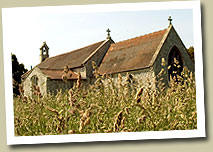 This church, though mediaeval, has the feel of the 18th century, with its towering three-decker pulpit, box-pews and 'bird-bath' font. Go to the Norfolk Churches Site maintained by Simon Knott: http://www.norfolkchurches.co.uk/warhammarymagdelene/ warhammarymagdelene.htm 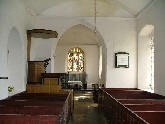 "You step inside to an interior that underwent a substantial restoration at the unusually early date of 1801. As Pevsner observes, this gives it great character, a feeling quite different to most medieval churches. The box pews, the three-decker pulpit, the communion rails - they are all of a piece, and probably the work of the same carpenter. Contemporary with them is the bird-bath font at the west end."  |
||||||||||||||||||||||||||||
| Waterden, All Saints |
Go to the
Norfolk Churches Site maintained by Simon Knott:
http://www.norfolkchurches.co.uk/waterden/waterden.htm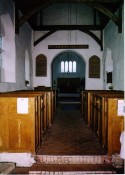 Box pews in the tiny church rescued by the Norfolk Churches Trust and restored for parochial use, even though in reality there isn't a parish, or at least any people nearby. |
||||||||||||||||||||||||||||
| Wiggenhall, St German | The church contains a Jacobean pulpit with an hour-glass stand. | ||||||||||||||||||||||||||||
| Wiggenhall, St Mary the Virgin | This church also contains a Jacobean pulpit with an hour-glass stand. | ||||||||||||||||||||||||||||
| Wilby, All Saints | The west gallery is dated 1637. The gallery is also the ringing chamber within the tower, and has turned balusters. There is also a three-decker pulpit half-way down the nave. | ||||||||||||||||||||||||||||
| Worstead, St Mary | One of the finest 'wool' churches of East Anglia. 1550 stone ringing gallery under tower. As at Cawston, Norfolk, there is an inscription along the front of the tower gallery: | ||||||||||||||||||||||||||||
|
|||||||||||||||||||||||||||||
|
Churches which are known to have had west gallery features or connections |
|||||||||||||||||||||||||||||
| King's Lynn, St Mary | There used to be a organ on a west gallery, now gone. | ||||||||||||||||||||||||||||
| Worstead, All Saints | The west gallery was removed in the 19th C. | ||||||||||||||||||||||||||||
| Asterisks denote churches in preparation | |||||||||||||||||||||||||||||
|
|
